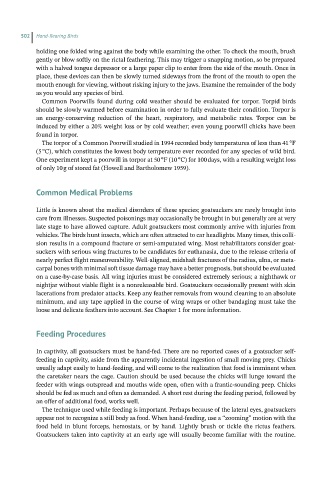Page 505 - Hand rearing birds second
P. 505
502 Hand-Rearing Birds
holding one folded wing against the body while examining the other. To check the mouth, brush
gently or blow softly on the rictal feathering. This may trigger a snapping motion, so be prepared
with a halved tongue depressor or a large paper clip to enter from the side of the mouth. Once in
place, these devices can then be slowly turned sideways from the front of the mouth to open the
mouth enough for viewing, without risking injury to the jaws. Examine the remainder of the body
as you would any species of bird.
Common Poorwills found during cold weather should be evaluated for torpor. Torpid birds
should be slowly warmed before examination in order to fully evaluate their condition. Torpor is
an energy‐conserving reduction of the heart, respiratory, and metabolic rates. Torpor can be
induced by either a 20% weight loss or by cold weather; even young poorwill chicks have been
found in torpor.
The torpor of a Common Poorwill studied in 1994 recorded body temperatures of less than 41 °F
(5 °C), which constitutes the lowest body temperature ever recorded for any species of wild bird.
One experiment kept a poorwill in torpor at 50 °F (10 °C) for 100 days, with a resulting weight loss
of only 10 g of stored fat (Howell and Bartholomew 1959).
Common Medical Problems
Little is known about the medical disorders of these species; goatsuckers are rarely brought into
care from illnesses. Suspected poisonings may occasionally be brought in but generally are at very
late stage to have allowed capture. Adult goatsuckers most commonly arrive with injuries from
vehicles. The birds hunt insects, which are often attracted to car headlights. Many times, this colli-
sion results in a compound fracture or semi‐amputated wing. Most rehabilitators consider goat-
suckers with serious wing fractures to be candidates for euthanasia, due to the release criteria of
nearly perfect flight maneuverability. Well‐aligned, midshaft fractures of the radius, ulna, or meta-
carpal bones with minimal soft tissue damage may have a better prognosis, but should be evaluated
on a case‐by‐case basis. All wing injuries must be considered extremely serious; a nighthawk or
nightjar without viable flight is a nonreleasable bird. Goatsuckers occasionally present with skin
lacerations from predator attacks. Keep any feather removals from wound cleaning to an absolute
minimum, and any tape applied in the course of wing wraps or other bandaging must take the
loose and delicate feathers into account. See Chapter 1 for more information.
Feeding Procedures
In captivity, all goatsuckers must be hand‐fed. There are no reported cases of a goatsucker self‐
feeding in captivity, aside from the apparently incidental ingestion of small moving prey. Chicks
usually adapt easily to hand‐feeding, and will come to the realization that food is imminent when
the caretaker nears the cage. Caution should be used because the chicks will lunge toward the
feeder with wings outspread and mouths wide open, often with a frantic‐sounding peep. Chicks
should be fed as much and often as demanded. A short rest during the feeding period, followed by
an offer of additional food, works well.
The technique used while feeding is important. Perhaps because of the lateral eyes, goatsuckers
appear not to recognize a still body as food. When hand‐feeding, use a “zooming” motion with the
food held in blunt forceps, hemostats, or by hand. Lightly brush or tickle the rictus feathers.
Goatsuckers taken into captivity at an early age will usually become familiar with the routine.

